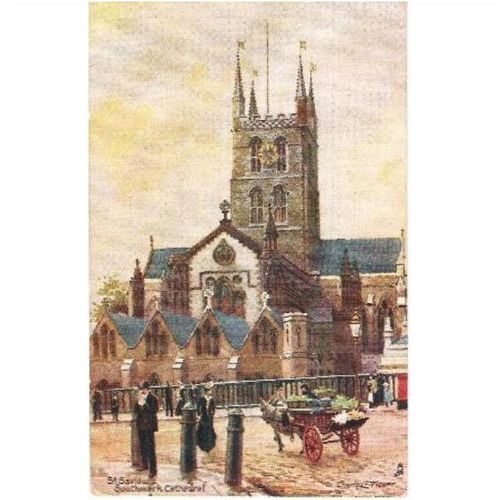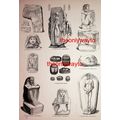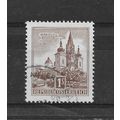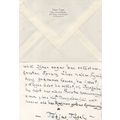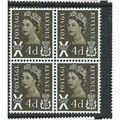London - Southwark Cathedral St Saviour - Charles Flowers art postcard Tuck 1904
- Condition : Used
- Dispatch : 2 Days
- Brand : None
- ID# : 128323394
- Quantity : 1 item
- Views : 489
- Location : United Kingdom

- Seller : justthebook (+1699)
- Barcode : None
- Start : Mon 19 May 2014 15:17:36 (EDT)
- Close : Run Until Sold
- Remain : Run Until Sold
Checks/Cheques
 for 1 item(s) edit
for 1 item(s) edit
Shipping Calculator
More Listings from This Seller view all
Seller's Description
- Postcard
- Picture / Image: St. Saviours Southwark Cathedral, London - by Charles Flowers
- Publisher: Raphael Tuck 'Aquarette' (6259)
- Postally used: yes
- Stamp: Edward VII half d. blueish green [the earlier shade]
- Postmark(s): London W. Sep 2 1904 cds
- Sent to: Miss Dancaind, 15 York Place, Baker Street, [London]
- Notes / condition:
Please ask if you need any other information and I will do the best I can to answer.
Image may be low res for illustrative purposes - if you need a higher definition image then please contact me and I may be able to send one.
------------------------------------------------
Postage & Packing:
UK (incl. IOM, CI & BFPO): 99p
Europe: £1.60
Rest of world (inc. USA etc): £2.75
No additional charges for more than one postcard. You can buy as many postcards from me as you like and you will just pay the fee above once. (If buying postcards with other things such as books, please contact or wait for invoice before paying).
Payment Methods:
UK - PayPal, Cheque (from UK bank) or postal order
Outside UK: PayPal ONLY (unless otherwise stated) please. NO non-UK currency checks or money orders (sorry).
NOTE: All postcards are sent in brand new stiffened envelopes which I have bought for the task. These are specially made to protect postcards and you may be able to re-use them. In addition there are other costs to sending so the above charge is not just for the stamp!
I will give a full refund if you are not fully satisfied with the postcard.
----------------------------------------------
Text from the free encyclopedia WIKIPEDIA may appear below to give a little background information (internal links may not work) :
*************
Southwark (Br ['s?ð?k])[2] Cathedral or The Cathedral and Collegiate Church of St Saviour and St Mary Overie, Southwark, London, lies on the south bank of the River Thames close to London Bridge. It is the mother church of the Anglican Diocese of Southwark. It has been a place of Christian worship for more than 1,000 years, but a cathedral only since the creation of the diocese of Southwark in 1905.
Between 1106 and 1538 it was the church of an Augustinian priory, Southwark Priory, dedicated to the Virgin Mary. Following the dissolution of the monasteries, it became a parish church, with the new dedication of St Saviour's. The church was in the diocese of Winchester until 1877, when the parish of St Saviour's, along with other South London parishes, was transferred to the diocese of Rochester. [3] The present building retains the basic form of the Gothic structure built between 1220 and 1420, although the nave is a late 19th-century reconstruction.
Borough Market is immediately to its south and the Hall of the Worshipful Company of Glaziers and Painters of Glass is on the riverside part of Montague Close on its north.
The 16th-century London historian John Stow recorded an account of the origins of the Southwark Priory of St Mary that he had heard from Bartholomew Linsted, who had been the last prior when the priory was dissolved.[4] Linsted claimed it had been founded as a nunnery ""long before the [Norman] Conquest"" by a maiden named Mary, on the profits of a ferry across the Thames she had inherited from her parents. Later it was converted into a college of priests by ""Swithen, a noble lady"". Finally in 1106 it was refounded as an Augustinian priory.
The tale of the ferryman's daughter Mary and her benefactions became very popular, but later historians tried to rationalise Linsted's story. Thus the author of an 1862 guidebook to the then St Saviour's church suggested it was probable that the ""noble lady"" Swithen had in fact been a man – Swithun, Bishop of Winchester from 852 or 853 until his death in 863.[5]
In the 20th century this identification was accepted by the Revd Thomas P. Stevens, Succentor and Sacrist, and later Honorary Canon, of Southwark Cathedral, who wrote a number of guidebooks to the cathedral, and a history that was revised and reprinted many times. He went on to date the foundation of the supposed original nunnery to ""about the year 606"", although he provided no evidence to support the date.[6] Although recent guidebooks are more circumspect, referring only to ""a tradition"", an information panel at the east end of the cathedral still claims that there had been ""A convent founded in 606 AD"" and ""A monastery established by St Swithun in the 9th century"".
...
By the early 19th century the fabric of the church had fallen into disrepair. All the medieval furnishings were gone, and the interior was as Francis Bumpus later described it, ""pewed and galleried to a fearful extent.""[19] Between 1818 and 1830, the tower and choir were restored by George Gwilt Jun.[8] In his efforts to return the church to its thirteenth century appearance, Gwilt removed the early sixteenth century windows at the east end of the choir and, lacking firm evidence as to the original design, substituted an elevation of his own invention, with three lancet windows, and a circular one in the gable above.[18] The transepts were restored, less sympathetically, by Robert Wallace.[8] The Bishop’s Chapel and parochial chapel were removed, but plans for the demolition of the retrochoir were averted, and it was restored by Gwilt in 1832.
At a vestry meeting held in May 1831 it was decided to remove the nave roof, which had become unsafe, leaving the interior open to the weather, and to hold all future services in the choir and transepts.[20] In 1839, the roofless nave was demolished to within seven feet of the ground,[21] and rebuilt to a design by Henry Rose.[8]
The new nave was at a higher level than the surviving mediaeval eastern part, and closed off from it by a glazed screen. It had a plaster vault carried on iron columns, and a wooden gallery around three sides.[22] It was widely criticised, notably by Pugin who wrote ""It is bad enough to see such an erection spring up at all, but when a venerable building is demolished to make way for it, the case is quite intolerable.""[23]
On the initiative of Anthony Thorold, Bishop of Rochester, the nave was once again rebuilt between 1890 and 1897[21] by Arthur Blomfield, in a manner intended to recreate its 13th century predecessor as accurately as possible, and to preserve the few surviving mediaeval fragments.[24]
The main railway viaduct connecting London Bridge station to Blackfriars, Cannon Street and Charing Cross stations passes only eighteen metres from the southeast corner of the cathedral, blocking the view from the south side. This was a compromise when the railway was extended along this viaduct in 1852; the alternative was to demolish the building completely to allow a more direct passage for the line.
The collegiate parish church of St Saviour was designated as a cathedral in 1905 when the Church of England Diocese of Southwark was created. The nearby early-18th-century church of St Thomas became the new cathedral's chapter-house.[25]
There are memorials to Isabella Gilmore and the victims of the Marchioness disaster, and monuments to Nelson Mandela and Desmond Tutu. In 2001 Mandela opened a new northern ""cloister"" on the site of the old monastic one, with a refectory, shop, conference centre, education centre and museum. In 2002, these Millennium buildings received an award for being one of the best new buildings of the year.
On 16 November 1996 the cathedral became a focus of controversy when it hosted a twentieth-anniversary service for the Lesbian and Gay Christian Movement. Jeffrey John, the Dean of St Albans and former bishop-elect of Reading, was Canon Theologian of Southwark.
The cathedral is used by London South Bank University for its annual honorary degree ceremony, by Regent's College for its graduation ceremonies, and by King's College London for its medical and dental degree ceremonies, an association stemming from its merger with Guy's and St Thomas' teaching hospitals, St Thomas' having started as an infirmary attached to the Priory of St Mary. The cathedral also hosts the London Nautical School's annual Christmas Carol Service.
There are two other cathedrals in Southwark: the Roman Catholic St George's Cathedral Southwark and the Greek Orthodox St Mary's at Camberwell New Road.
The interior of the Cathedral was used for the filming of the wedding scenes in the film The Slipper and the Rose (1976) (as revealed by director Bryan Forbes in his DVD commentary).[citation needed] Parts of the Doctor Who episode ""The Lazarus Experiment"" take place at Southwark Cathedral but, although the exterior appears, the interior shots were filmed at Wells Cathedral.
type=printed postcards
theme=topographical: british
sub-theme=england
county/ country=london
number of items=single
period=pre - 1914
postage condition=posted
Listing Information
| Listing Type | Gallery Listing |
| Listing ID# | 128323394 |
| Start Time | Mon 19 May 2014 15:17:36 (EDT) |
| Close Time | Run Until Sold |
| Starting Bid | Fixed Price (no bidding) |
| Item Condition | Used |
| Bids | 0 |
| Views | 489 |
| Dispatch Time | 2 Days |
| Quantity | 1 |
| Location | United Kingdom |
| Auto Extend | No |


